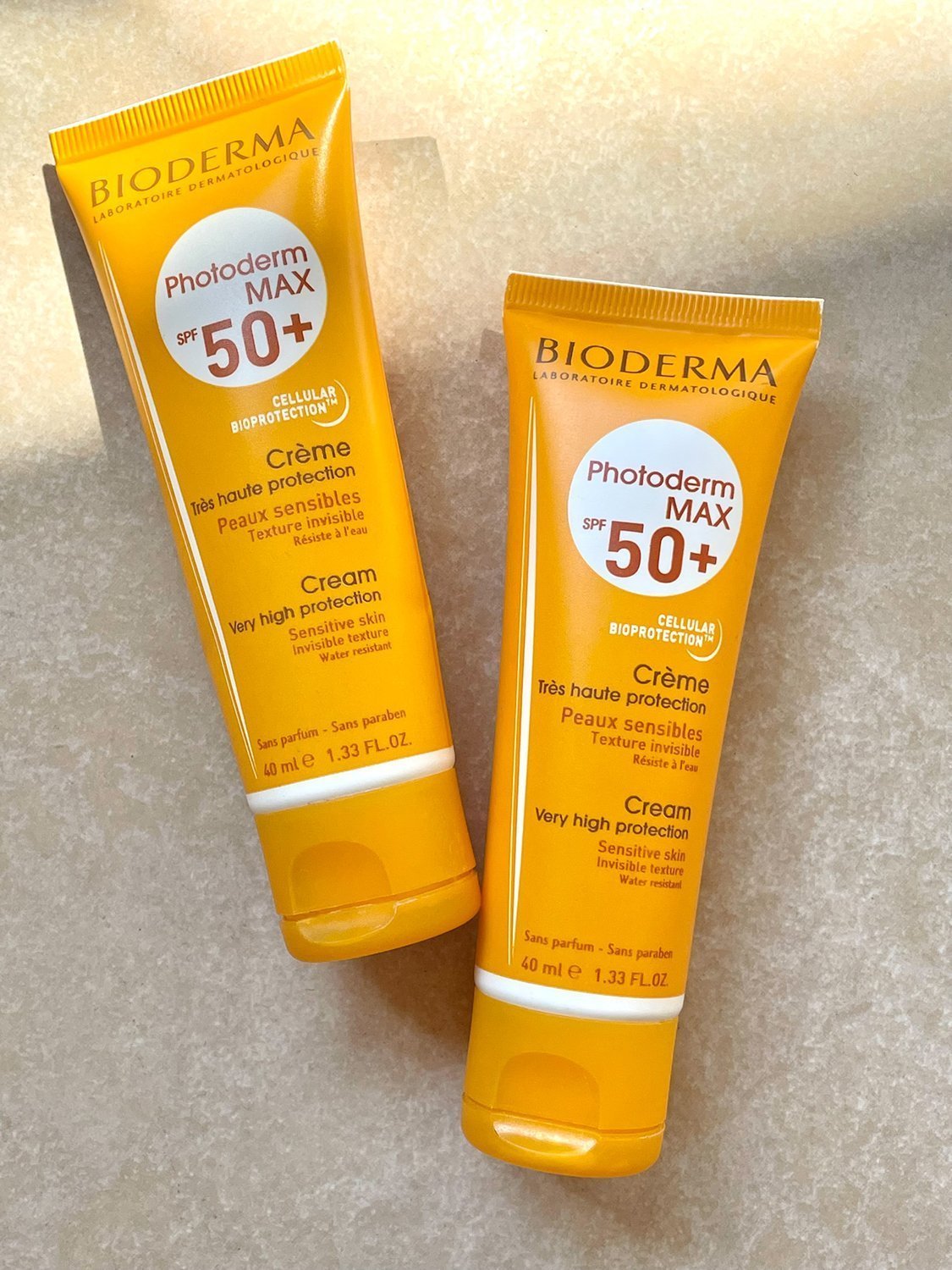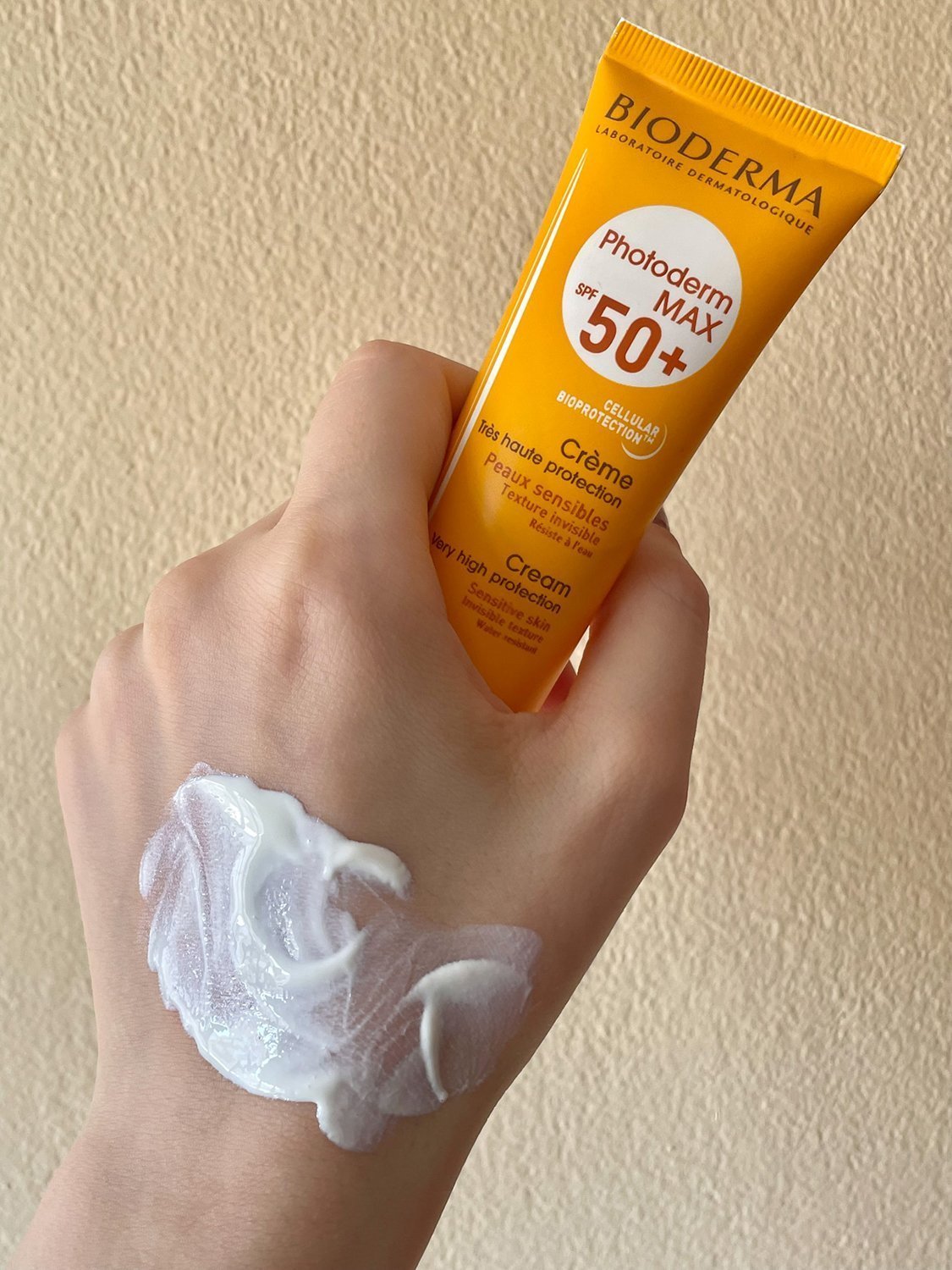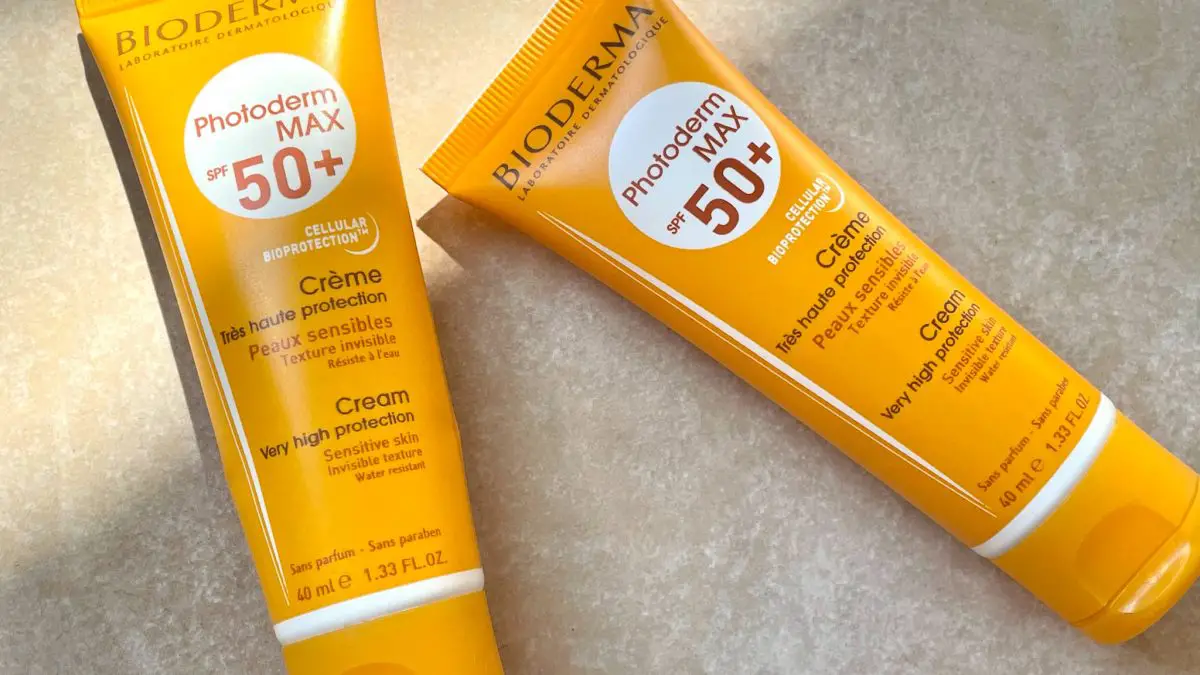The Bioderma Photoderm MAX Cream SPF 50+ is a chemical (organic) sunscreen. It has an SPF of 50+ and PPD 42. PPD stands for Persistent Pigment Darkening and measures the UVA protection factor.
As we know, UVA penetrate more deeply into the skin and can cause premature aging. The UVA protection in this sunscreen is really high, which is superb for preventing wrinkles and protecting your skin from sun damage!
Price: $25-$30
Volume: 40ml (1.35 fl.oz.)
PAO: 9 months after opening.
Application
Apply generously before sun exposure. Do not use oils or heavy moisturizers that form a film on top of the skin before sunscreen because it needs to adhere well to the skin and oils will make it move around and not apply evenly. Thus decreasing protection.
This is a water resistant sunscreen which is suitable for the beach or outdoor activities. Reapply often before and after swimming / sports / exercise.

Texture
It has a fluid creamy texture and glides really well on the skin. Dries down fast (or I’d rather say adheres fast) so you need to apply it quickly and avoid overblending it because it can ball up.
Scent
It does not contain any parfume so it just smells like usual sunscreen.
How does the Bioderma Photoderm MAX Cream SPF 50+ perform
This sunscreen is made for normal to dry skin types, but I didn’t notice that it was in a cream form when I purchased it. Anyway, I kept it so I could test it and here are my thoughts on it:
The sunscreen is moisturizing with a dewy finish which on my skin can look a bit greasy at times. The finish also depends on what skincare products you’re using under it.
There were a few times that I was looking like a grease ball because I used skincare that was too rich for my skin. Other times, I applied products that were lighter in consistency and some were oil controlling so the sunscreen definitely looked better and more natural.
For dry skin I don’t think you’d have this problem. I’ve tested it on dry areas of my body and it actually absorbs well without any greasy or sticky feeling.

Generally, upon application it does leave a very slight whitecast. The whitecast usually goes away after 20 minutes.
I like a dewy complexion but I feel like this is more on the greasy side than dewy for me in the summer time, so I’m not always a fan. So, for daily wear in humid weather, it’s far from ideal for my oily dehydrated skin. Especially when it comes to re-applying it! It will look shinier.
But one simple trick that you can use if you’ve already bought it and face the same problem is: Setting Powder.
Also Read: Vichy Idéal Soleil Anti-Ageing 3-in-1 Antioxidant Care SPF50 Review
You should do this after the sunscreen has fully set. I used to use a blotting paper, but to be honest, it does remove some of the sunscreen even with light tapping on the skin, so I feel more comfortable with the powder.
On the other hand, I love this for the beach and don’t mind it’s greasiness in this case. This is because I swim a lot and my skin becomes really dry due to the sea water. And actually the oil content helps with keeping the skin moisturized.
It is labeled as hypoallergenic and non-comedogenic. Personally, it did not break me out or irritate my skin in any way.
Ingredients
Active ingredients / UV Filters: Octocrylene (UVB/ Shortwave UVA), Tinosorb M (UVA/UVB) – a new generation hybrid filter , Avobenzone (UVA), Tinosorb S (UVA/UVB), Bisoctrizole (UVA/UVB).
It contains newer superior filters that are photostable. Fragrance-free.
Aqua/water/eau, Dicaprylyl Carbonate, Octocrylene, Methylene Bis-benzotriazolyl Tetramethylbutylphenol [nano], Butyl Methoxydibenzoylmethane, Bis-ethylhexyloxyphenol Methoxyphenyl Triazine, Cyclopentasiloxane, C20-22 Alkyl Phosphate, Glyceryl Stearate, Peg-100 Stearate, Ectoin, Mannitol, Xylitol, Rhamnose, Fructooligosaccharides, Laminaria Ochroleuca Extract, C20-22 Alcohols, Decyl Glucoside, Cyclohexasiloxane, Hydroxyethyl Acrylate/ Sodium Acryloyldimethyl Taurate Copolymer, Pentylene Glycol, Xanthan Gum, Propylene Glycol, Citric Acid, Caprylic/capric Triglyceride, Sodium Hydroxide, Disodium Edta, Phenoxyethanol, Chlorphenesin. [bi543]
Final Verdict on the Bioderma Photoderm Sunscreen
Pros
- Moisturizing.
- Soft finish.
- Very high UVB & UVA protection.
- Spreads and glides easily on the skin.
- Most suitable for normal, dry, mature and sensitive skin.
- It didn’t break me out.
- Water resitant.
- Fragrance-free.
Cons
- Looks dewy upon application and takes a while to absorb (for oily skin).
- Slight whitecast.
Despite not being very suitable for my skin type for daily wear due to the fact that it looks shiny, I do like this sunscreen and actually love to use it at the beach (Edit: I actually repurchased it for this purpose!). It did not irritate my skin and offers great broad spectrum protection! That UVA protection in this is very impressive!
Darker skin tones should be aware of the slight white cast. And in general, I think it will be more suitable for dry skin types. So if your skin is on the dry side, most likely you also won’t have any problem applying makeup over this. I may try the Aquafluide version in the future and see how it’ll perform compared to this one. Overall, it’s a sunscreen that I would recommend!
Did you find this Bioderma Photoderm MAX Cream SPF 50+ Sunscreen Review helpful? Have you tried this before?
Also Read:
NUXE Sun Delicious Cream High Protection SPF30 Review
Avene Very High Protection Dry Touch Fluid SPF 50+ Review
I’ve bought this product myself and I will always share my honest opinion and experience. Sincerely thankful to all of you that support my blog! For more information, see Disclosure Policy.
Related posts
2 Comments
Leave a Reply Cancel reply
Follow blog via Email
Get the latest posts from this blog delivered to your inbox!
About Me
Hi and welcome to Kbeauty Notes! :)
I’m Ledia and I’m very passionate about everything skincare. I created this blog to share my thoughts and experience with many amazing and not so great products out there, hoping to help you make better decisions regarding your skin.
I’m very happy to bring you on this journey with me and I hope you enjoy it! <3
My Skin Type: Oily, acne prone, dehydrated, a little sensitive, large pores.
Skincare Concerns: hydration, pore care, anti-ageing, PIE (acne marks), brightening.
Contact: kbeautynotes@gmail.com





Can it be used for oily and acne face?
Yes, it can be used, but it depends on how oily your skin is, and since it’s a cream type, it can be a little on the heavy side when used during summer. You can try the Aquafluide version which has a lighter consistency.
You can also check out my review on Vichy Idéal Soleil Anti-Ageing 3-in-1 Antioxidant Care SPF50 since it has a matte finish and maybe you’ll find it more suitable for your skin type.
Keep an eye out for more sunscreen reviews coming soon 🙂